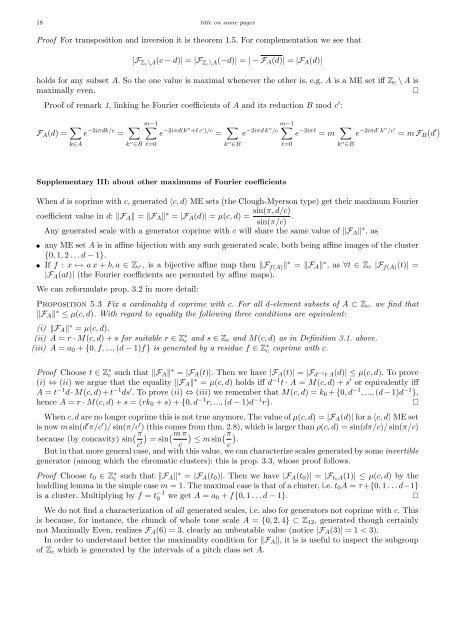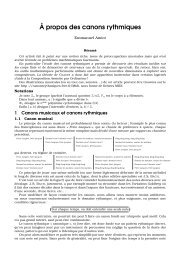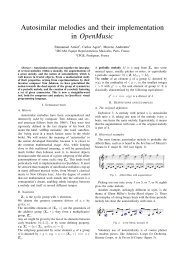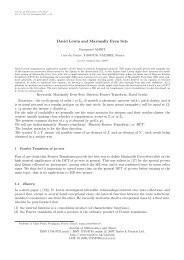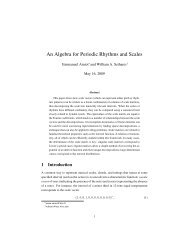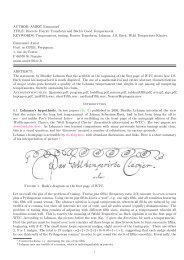Emmanuel Amiot Modèles algébriques et algorithmes pour la ...
Emmanuel Amiot Modèles algébriques et algorithmes pour la ...
Emmanuel Amiot Modèles algébriques et algorithmes pour la ...
Create successful ePaper yourself
Turn your PDF publications into a flip-book with our unique Google optimized e-Paper software.
18 title on some pages<br />
Proof For transposition and inversion it is theorem 1.5. For complementation we see that<br />
|F Zc\A(c − d)| = |F Zc\A(−d)| = | − FA(d)| = |FA(d)|<br />
holds for any subs<strong>et</strong> A. So the one value is maximal whenever the other is, e.g. A is a ME s<strong>et</strong> iff Zc \ A is<br />
maximally even. <br />
Proof of remark 1, linking he Fourier coefficients of A and its reduction B mod c ′ :<br />
FA(d) = <br />
e −2iπdk/c = <br />
k∈A<br />
m−1 <br />
k ′′ ∈B ℓ=0<br />
e −2iπd(k′′ +ℓ c ′ )/c = <br />
k ′′ ∈B<br />
e −2iπd k′′ m−1<br />
/c<br />
Supplementary III: about other maximums of Fourier coefficients<br />
<br />
e −2iπℓ = m <br />
ℓ=0<br />
k ′′ ∈B<br />
e −2iπd′ k ′′ /c ′<br />
= m FB(d ′ )<br />
When d is coprime with c, generated 〈c, d〉 ME s<strong>et</strong>s (the Clough-Myerson type) g<strong>et</strong> their maximum Fourier<br />
coefficient value in d: FA = FA∗ sin(π, d/c)<br />
= |FA(d)| = µ(c, d) =<br />
sin(π/c) .<br />
Any generated scale with a generator coprime with c will share the same value of FA∗ , as<br />
• any ME s<strong>et</strong> A is in affine bijection with any such generated scale, both being affine images of the cluster<br />
{0, 1, 2 . . . d − 1}.<br />
• If f : x ↦→ a x + b, a ∈ Zc ′, is a bijective affine map then F f(A) ∗ = FA ∗ , as ∀t ∈ Zc |F f(A)(t)| =<br />
|FA(at)| (the Fourier coefficients are permuted by affine maps).<br />
We can reformu<strong>la</strong>te prop. 3.2 in more d<strong>et</strong>ail:<br />
Proposition 5.3 Fix a cardinality d coprime with c. For all d-element subs<strong>et</strong>s of A ⊂ Zc. we find that<br />
FA ∗ ≤ µ(c, d). With regard to equality the following three conditions are equivalent:<br />
(i) FA ∗ = µ(c, d).<br />
(ii) A = r · M(c, d) + s for suitable r ∈ Z ∗ c and s ∈ Zc and M(c, d) as in Definition 3.1. above.<br />
(iii) A = a0 + {0, f, ..., (d − 1)f} is generated by a residue f ∈ Z ∗ c coprime with c.<br />
Proof Choose t ∈ Z ∗ c such that FA ∗ = |FA(t)|. Then we have |FA(t)| = |Fd −1 t·A(d)| ≤ µ(c, d). To prove<br />
(i) ⇔ (ii) we argue that the equality FA ∗ = µ(c, d) holds iff d −1 t · A = M(c, d) + s ′ or equivalently iff<br />
A = t −1 d · M(c, d) + t −1 ds ′ . To prove (ii) ⇔ (iii) we remember that M(c, d) = k0 + {0, d −1 , ..., (d − 1)d −1 },<br />
hence A = r · M(c, d) + s = (rk0 + s) + {0, d −1 r, ..., (d − 1)d −1 r}. <br />
When c, d are no longer coprime this is not true anymore. The value of µ(c, d) = |FA(d)| for a 〈c, d〉 ME s<strong>et</strong><br />
is now m sin(d ′ π/c ′ )/ sin(π/c ′ ) (this comes from thm. 2.8), which is <strong>la</strong>rger than ρ(c, d) = sin(dπ/c)/ sin(π/c)<br />
because (by concavity) sin π<br />
c ′<br />
m π π <br />
= sin ≤ m sin .<br />
c<br />
c<br />
But in that more general case, and with this value, we can characterize scales generated by some invertible<br />
generator (among which the chromatic clusters): this is prop. 3.3, whose proof follows.<br />
Proof Choose t0 ∈ Z ∗ c such that FA ∗ = |FA(t0)|. Then we have |FA(t0)| = |Ft0A(1)| ≤ µ(c, d) by the<br />
huddling lemma in the simple case m = 1. The maximal case is that of a cluster, i.e. t0A = τ +{0, 1 . . . d−1}<br />
is a cluster. Multiplying by f = t −1<br />
0 we g<strong>et</strong> A = a0 + f{0, 1 . . . d − 1}. <br />
We do not find a characterization of all generated scales, i.e. also for generators not coprime with c. This<br />
is because, for instance, the chunck of whole tone scale A = {0, 2, 4} ⊂ Z12, generated though certainly<br />
not Maximally Even, realizes FA(6) = 3, clearly an unbeatable value (notice |FA(3)| = 1 < 3).<br />
In order to understand b<strong>et</strong>ter the maximality condition for FA, it is is useful to inspect the subgroup<br />
of Zc which is generated by the intervals of a pitch c<strong>la</strong>ss s<strong>et</strong> A.


